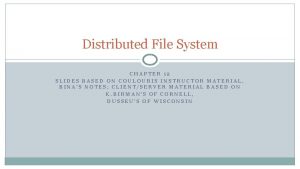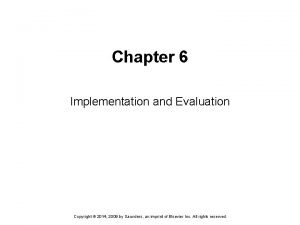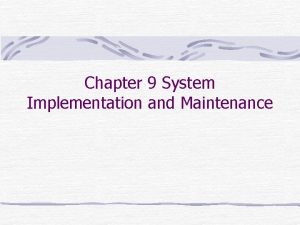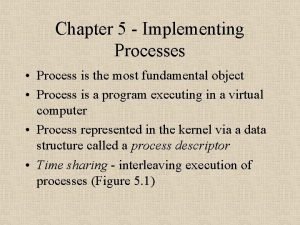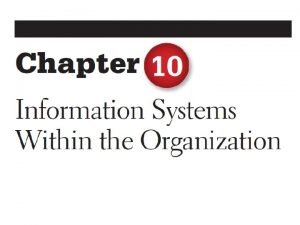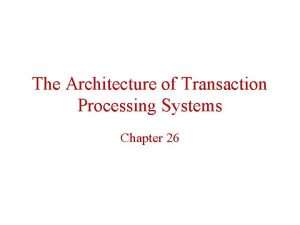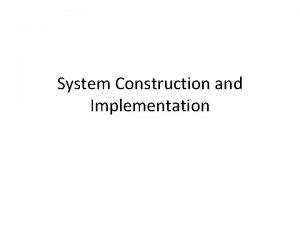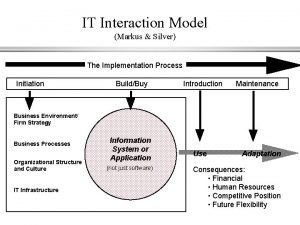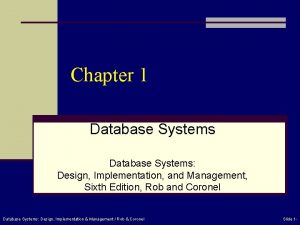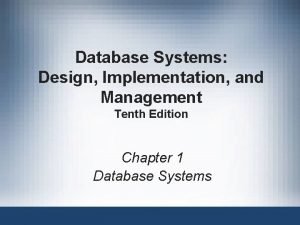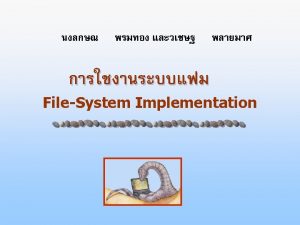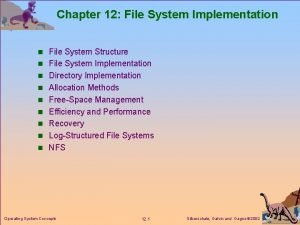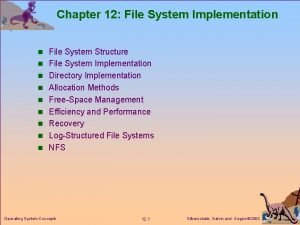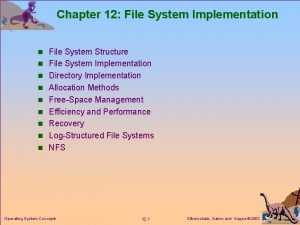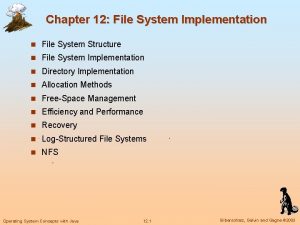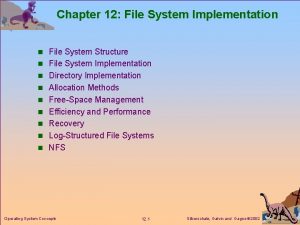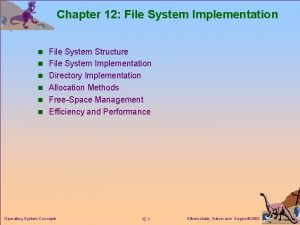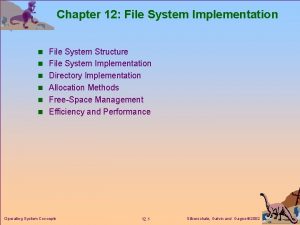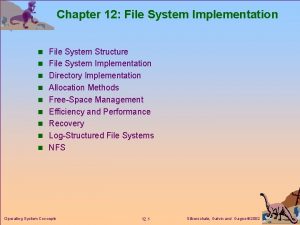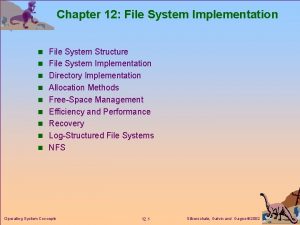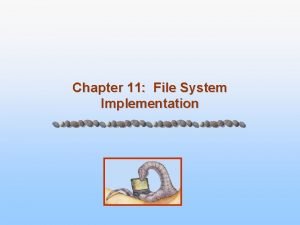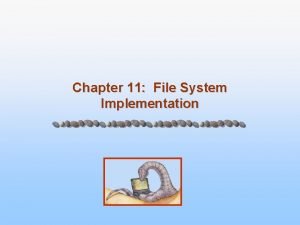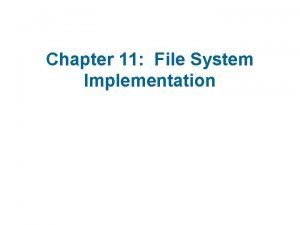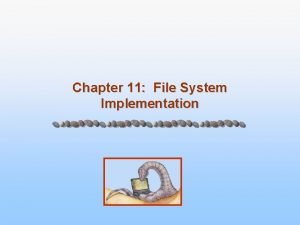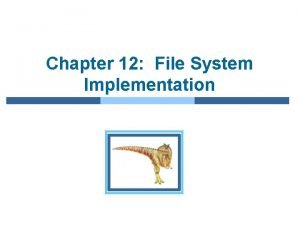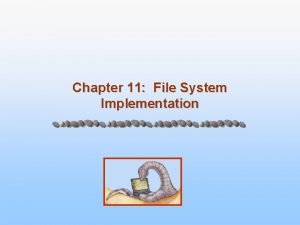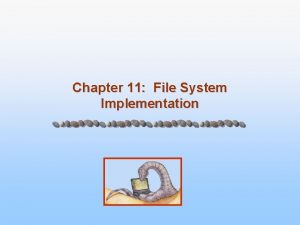Chapter 12 File System Implementation 1 File System





















- Slides: 21

Chapter 12: File System Implementation § § § 1 File System Structure File System Implementation Directory Implementation Allocation Methods Free-Space Management Unix File System, Inodes, etc.

Moving-Head Disk Mechanism 2

Disk Addressing § Fundamental unit (block) of information is the sector (generally a power of 2 in size) § Sectors are arranged on tracks on a platter § If multiple platters, we organize the tracks into cylinders § We may also organize groups of cylinders to make partitions § File systems work in terms of logical blocks • So one lower level issue on mass storage devices is the mapping of logical block address to physical blocks § Platter #, Cylinder # (Track #), Sector # 3

File-System Structure § File structure • • Logical storage unit Collection of related information Sequential access, or Random (“direct”) access § i. e. Selective access to individual records/blocks § Several on-disk and in-memory structures are used to implement a file system § File system organized into layers. 4

Layered File System Manages meta date about files, file organization, directory structure, file control blocks, etc. Mapping of logical block# (0. . n) to physical block# (sector, track #, etc), free space mgmt Issues generic commands to device drive to R/W physical blocks on disk Device drivers, interrupt service routines, etc 5

On-disk structures 6 § Boot control block (boot block/partition boot sector) contains info needed to boot OS from that partition. Can be empty if disk does not contain OS. § Partition control block (superblock, Master File Table) contains partition details such as: # blocks in partition, size of blocks, free -block count, free-block pointer, free FCB count and pointers § A directory structure is used to organize the files

File Control Block • A storage structure consisting of information about a file. • In UFS called an inode, in NTFS is stored w/in the Master File Table (access control list) 7 (i. e. pointer(s) to data blocks)

In-memory structures § In-memory partition table containing info about each mounted partition § In-memory directory structure contains info of recently accessed directories § System-wide open-file table contains copy of FCB of each open file & other info § Per-process open-file table contain a pointer to entry in system-wide open file table & other info 8

In-Memory File System Structures Opening A file Reading A file 9

Virtual File Systems § Virtual File Systems (VFS) provide an objectoriented way of implementing file systems. § VFS allows the same system call interface (the API) to be used for different types of file systems. • e. g. hard drives, floppy disk, CD, Network § The API is to the VFS interface, rather than any specific type of file system. 10

Schematic View of Virtual File System 11

Directory Implementation § Linear list of file names with pointers to the data blocks. • simple to program • Slow search if many files § Hash Table – linear list with hash data structure. • Hash table takes value created from file name and returns ptr to to the file name in the linear list • decreases directory search time • collisions – situations where two file names hash to the same location • fixed size 12

Allocation Methods § An allocation method refers to how disk blocks are allocated for files: • Contiguous allocation • Linked allocation • Indexed allocation § For these approaches we regard the file system blocks to be numbered sequentially 0. . n • Mapping to track and sector # done at a lower level 13

Contiguous Allocation § Each file occupies a set of contiguous blocks on the disk. § Simple – only starting location (block #) and length (number of blocks) are required. § Supports sequential and direct access § Wasteful of space • dynamic storage-allocation problem (set of holes), external fragmentation § Files cannot easily grow. 14

Contiguous Allocation of Disk Space 15

Extent-Based Systems § Some newer file systems (e. g. Veritas File System) use a modified contiguous allocation scheme. § Extent-based file systems allocate disk blocks in extents. § An extent is a contiguous block of disks. Extents are allocated for file allocation. A file consists of one or more extents. § Can add extents over time. 16 § Large extents can lead to internal fragmentation

Linked Allocation § Each file is a linked list of disk blocks: blocks may be scattered anywhere on the disk. block 17 = pointer 4 bytes?

Linked Allocation (Cont. ) § Simple – need only starting address § Free-space management system – no waste of space (linked list of free blocks, too) § Sequential access easy (keep following the chain) § Random access difficult (must step through linked blocks, many disk accesses along the way) 18

Linked Allocation 19

File-Allocation Table others) • Section of disk at start of partition • Table with one entry per disk block • Indexed by block# • Each entry contains link to next block • Special code for EOF • “ 0” means empty block 20 (DOS,

File Allocation Table § Removes link pointer from blocks themselves § FAT can be cached in memory for quick access § Better support for random access • Can find block quickly by traversing the table • Don’t need to access all the blocks on the way § Easy to find empty blocks, and to extend files 21
 File-file yang dibuat oleh user pada jenis file di linux
File-file yang dibuat oleh user pada jenis file di linux Distributed file system implementation
Distributed file system implementation Distributed file system definition
Distributed file system definition In a file-oriented information system, a transaction file
In a file-oriented information system, a transaction file Difference between logical file and physical file
Difference between logical file and physical file Fungsi sistem file
Fungsi sistem file Markup tag tells the web browser
Markup tag tells the web browser Chapter 6 implementation and evaluation
Chapter 6 implementation and evaluation System maintenance must be performed to
System maintenance must be performed to Implementation of process in operating system
Implementation of process in operating system System design implementation and operation
System design implementation and operation A transaction is any business event that generates
A transaction is any business event that generates A deployment descriptor describes *
A deployment descriptor describes * What is system construction
What is system construction The most creative and challenging phase of sdlc is
The most creative and challenging phase of sdlc is Cse132c
Cse132c Rpc implementation in distributed system
Rpc implementation in distributed system System implementation process under it interaction model
System implementation process under it interaction model Database system design implementation and management
Database system design implementation and management A model that is the demo implementation of the system.
A model that is the demo implementation of the system. State of the art contracting
State of the art contracting Database systems design implementation and management
Database systems design implementation and management

